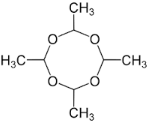Metaldehyde 四聚乙醛
Introduction: Metaldehyde is a molluscicide used to attract and kill slugs and snails. It is used in a variety of vegetable and ornamental crops in the field or greenhouse, on fruit trees, small-fruit plants, or in avocado or citrus orchards, berry plants and banana plants. It is applied to the soil around plants. Care should be taken not to contaminate edible parts of the plant. It is used in the form of granules, sprays and dusts, or mixed with bran as a bait. It works primarily in the stomach by producing toxic effects after it is ingested by the pest. Metaldehyde is available in pelleted baits.
Common name: Metaldehyde
Another name: Metacetaldehyde; Cekumeta; Ariotox; Halizan; Metason; Acetaldehyde, tetramer; Slug-Tox; etc.
Chemical name: 2,4,6,8-tetramethyl-1,3,5,7-tetraoxacyclooctane
Empirical formula: C8H16O4
Structural formula:

Mol. Weight: 176.21 g/mol
CAS No.: 108-62-3
Specifications
Leading Metaldehyde supplier
Metaldehyde 98% TC
Metaldehyde 80% WP
Metaldehyde 6% GR
Metaldehyde 5% GR
Packing:
BULK PACKING
Powder: 25kg/Bag, 25kg/Drum, 50kg/Drum etc.
Liquid: 200L/Drum, 20L/Drum, 10L/Drum etc.
SMALL PACKING
Powder: 1kg/Alu bag, 500g/Alu bag, 200g/Alu bag, 100g/Alu bag, 50g/Alu bag, 15g/Alu bag etc.
Liquid: 5L/Drum, 1L/Bottle, 500ml/Bottle, 250ml/Bottle, 100ml/Bottle, 50ml/Bottle etc.
Customerized packing label
Metaldehyde FAO standard
Professional registration
HAZARDS IDENTIFICATION
Hazard statement(s)
H228: Flammable solid.
H301: Toxic if swallowed.
H302: Harmful if swallowed.
H312: Harmful in contact with skin.
H412: Harmful to aquatic life with long lasting effects.
Precautionary statement(s)
P210: Keep away from heat, hot surface, sparks, open flames and other ignition sources. - No smoking.
P264: Wash ... thoroughly after handling.
P270: Do not eat, drink or smoke when using this product.
P280: Wear protective gloves/protective clothing/eye protection/face protection.
P301+P312: IF SWALLOWED: call a POISON CENTER/doctor/... IF you feel unwell.
P302+P352: IF ON SKIN: wash with plenty of water.
P312: Call a POISON CENTER or doctor/... if you feel unwell.
P322: Specific measures (see ...on this label).
P330: Rinse mouth.
P363: Wash contaminated clothing before reuse.
P501: Dispose of contents/container to.
Supplemental Hazard Statements: none.
MAMMALIAN TOXICOLOGY
Acute toxicity: 1) Acute oral LD50 for rats is 283 mg/kg. 2) Acute dermal LD50 for rats is >5000 mg/kg. 3) Acute inhalation toxicity LC50 (4 h) for rats is >15.0 mg/l. 4) Skin irritation: Non-irritating to skin (rabbits). 5) Eye irritation: Non-irritating to eyes (rabbits). 6) Skin sensitization for guinea pig: Not a skin sensitiser.
NOEL: NOEL (21 days) for rabbits is 1000 mg/kg, NOEL (90 days) for rats is 21 mg/kg, NOEL (104 weeks) for rats is 2 mg/kg. Other Not carcinogenic, not teratogenic.
ADI 0.02 mg/kg b.w.
Classification:
WHO Classification: II (Moderately hazardous)
EC Risk Classification: Xn - Harmful: R22; H - Handling risks: R11.
US EPA Classification (formulation): III, II (Caution - Slightly toxic, Warning - Moderately toxic)
ECOTOXICOLOGY
Effect on birds: Acute oral LD50 for Mallard is 196 mg/kg. Effect on fish: Acute LC50 (96 h) for Rainbow trout is 75 mg/l. Effects on aquatic invertebrates: Acute EC50 (48 h) for Daphnia magna is >78.4 mg/l. Effects on algae: Acute EC50 (72 h) for Scenedemus subspicatus is 75.9 mg/l. Effects on bees: Contact acute (48 h) LD50 is >113 μg/bee, Oral acute (48 h) LD50 is >87.5 μg/bee. Effects on earthworms: Acute 14 day LC50 is >1000 mg/kg.
ENVIRONMENTAL FATE
Breakdown in soil and groundwater: Metaldehyde is of low persistence in the soil environment, with a half-life on the order of several days. It is weakly sorbed by soil organic matter and clay particles, and is soluble in water. Due to its low persistence, it is not a significant risk to groundwater. Breakdown in water: Metaldehyde undergoes rapid hydrolysis to acetaldehyde, and should be of low perstistence in the aquatic environment. Breakdown in vegetation: Many types of flowers lose their color when they come in contact with metaldehyde dust or spray.
Usage: Metaldehyde is applied as a molluscicide bait for controlling slugs and snails in a very wide range of agricultural and horticultural crops, and by members of the public to control slugs and snails in their gardens and allotments.
Application: Mode of action Molluscicide with contact and stomach action. Metaldehyde-poisoned slugs secrete large quantities of slime, desiccate and die. Their mucus cells are irreversibly destroyed. Uses Metaldehyde is a molluscicide used in a variety of vegetable and ornamental crops in the field or greenhouse, on fruit trees, small-fruit plants, or in avocado or citrus orchards, berry plants, and banana plants. It is used to attract and kill slugs and snails. It is applied in the form of granules, sprays, and dusts, or pelleted or grain bait, typically to the ground around the plants or crops. It works primarily in the stomach by producing toxic effects after it is ingested by the pest.
| 






